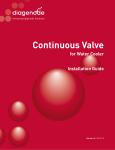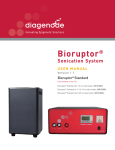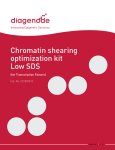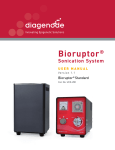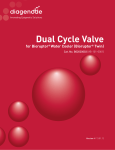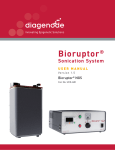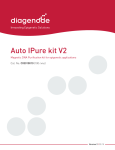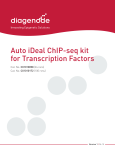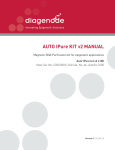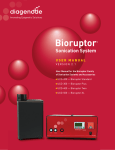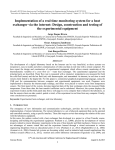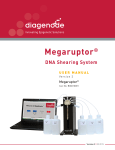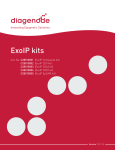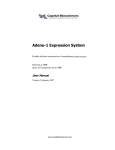Download Bioruptor® Pico
Transcript
Bioruptor ® Sonication System USER MANUAL Ve rs i o n 1 . 1 Bioruptor® Pico Cat. No. B01060001 Pico PAGE 2 DIAGENODE BIORUPTOR® PICO USER MANUAL Guarantee Limited one year global warranty Diagenode guarantees all products from any manufacturing defects as we rigorously test all products to meet strict quality standards. Diagenode warrants that all standard components of its instruments will be free of defects in materials and workmanship for a period of one (1) year from the date that the warranty period begins, unless the original quotation or accompanying documentation states a different warranty period. All warranty periods begin on the date of delivery and apply only to the first purchaser of the product. If a manufacturing defect arises and a valid claim is received within the warranty period, Diagenode, at its discretion, will repair or replace the product in accordance with the warranty terms and conditions stated herein. In case of repair or replacement of a product under warranty, Diagenode will cover the expenses to return the repaired or replacement product. This warranty covers only manufacturing defects and does not cover any damage caused by misuse, lack of compliance to recommendations stated in the manual, neglect, accidents, abrasion, or exposure to extreme temperatures, chemical solvents, or acids. We strongly recommend that maintenance or repairs of Diagenode’s products are performed by our approved Diagenode service center. Improper or incorrectly performed maintenance or repairs will void the warranty. Technical assistance & ordering information Diagenode s.a. BELGIUM | EUROPE Diagenode Inc. USA | NORTH AMERICA LIEGE SCIENCE PARK 400 Morris Avenue, Suite #101 Rue Bois Saint-Jean, 3 Denville, NJ 07834 - USA 4102 Seraing (Ougrée) - Belgium Tel: +1 862 209-4680 Tel: +32 4 364 20 50 Fax: +1 862 209-4681 Fax: +32 4 364 20 51 [email protected] [email protected] [email protected] [email protected] For a complete listing of Diagenode’s international distributors visit: www.diagenode.com/en/support/distributors.php For the rest of the world, please contact Diagenode s.a. Europe Diagenode sa / LIEGE SCIENCE PARK // Rue du Bois Saint-Jean, 3 // 4102 Seraing (Ougrée) // Belgium // Phone: (+32) 4 364 20 50 // Mail: [email protected] DIAGENODE BIORUPTOR® PICO USER MANUAL PAGE 3 Contents Critical steps for maintenance and efficient shearing . . . . . . . . . . . . . . . . . . . . . . . . . . . . . . . . . . . . . . 4 Introduction. . . . . . . . . . . . . . . . . . . . . . . . . . . . . . . . . . . . . . . . . . . . . . . . . . . . . . . . . . . . . . . . . . . . . . . . . . 5 Bioruptor ® Pico technical specifications. . . . . . . . . . . . . . . . . . . . . . . . . . . . . . . . . . . . . . . . . . . . . . . . . . 6 Getting to know your Bioruptor ® Pico system . . . . . . . . . . . . . . . . . . . . . . . . . . . . . . . . . . . . . . . . . . . . . 7 Bioruptor® Pico components overview. . . . . . . . . . . . . . . . . . . . . . . . . . . . . . . . . . . . . . . . . . . . . . . . . 7 Bioruptor® Pico Water Cooler . . . . . . . . . . . . . . . . . . . . . . . . . . . . . . . . . . . . . . . . . . . . . . . . . . . . . . . . 7 Single cycle valve for Bioruptor® Pico. . . . . . . . . . . . . . . . . . . . . . . . . . . . . . . . . . . . . . . . . . . . . . . . . . 8 Sonication bath. . . . . . . . . . . . . . . . . . . . . . . . . . . . . . . . . . . . . . . . . . . . . . . . . . . . . . . . . . . . . . . . . . . . 8 Motorized lid. . . . . . . . . . . . . . . . . . . . . . . . . . . . . . . . . . . . . . . . . . . . . . . . . . . . . . . . . . . . . . . . . . . . . . 9 Tube holders. . . . . . . . . . . . . . . . . . . . . . . . . . . . . . . . . . . . . . . . . . . . . . . . . . . . . . . . . . . . . . . . . . . . . . 9 Equipment installation . . . . . . . . . . . . . . . . . . . . . . . . . . . . . . . . . . . . . . . . . . . . . . . . . . . . . . . . . . . . . . . 10 Installation overview . . . . . . . . . . . . . . . . . . . . . . . . . . . . . . . . . . . . . . . . . . . . . . . . . . . . . . . . . . . . . . 10 Installing the Bioruptor® Pico system with Water Cooler. . . . . . . . . . . . . . . . . . . . . . . . . . . . . . . . . 11 Controlling the sonication. . . . . . . . . . . . . . . . . . . . . . . . . . . . . . . . . . . . . . . . . . . . . . . . . . . . . . . . . . . . . 14 Tube holders and tubes. . . . . . . . . . . . . . . . . . . . . . . . . . . . . . . . . . . . . . . . . . . . . . . . . . . . . . . . . . . . . . . 16 Standard protocol for DNA shearing. . . . . . . . . . . . . . . . . . . . . . . . . . . . . . . . . . . . . . . . . . . . . . . . . . . . 17 Operating conditions . . . . . . . . . . . . . . . . . . . . . . . . . . . . . . . . . . . . . . . . . . . . . . . . . . . . . . . . . . . . . . 17 Important comments about DNA shearing . . . . . . . . . . . . . . . . . . . . . . . . . . . . . . . . . . . . . . . . . . . . 20 Small volume DNA shearing for Bioruptor ® Pico . . . . . . . . . . . . . . . . . . . . . . . . . . . . . . . . . . . . . . . . . 22 Operating conditions . . . . . . . . . . . . . . . . . . . . . . . . . . . . . . . . . . . . . . . . . . . . . . . . . . . . . . . . . . . . . . 22 Important comments about DNA shearing . . . . . . . . . . . . . . . . . . . . . . . . . . . . . . . . . . . . . . . . . . . . 25 Consistent and highly reproducible chromatin shearing with the Bioruptor® Pico �����������������������25 Ordering information. . . . . . . . . . . . . . . . . . . . . . . . . . . . . . . . . . . . . . . . . . . . . . . . . . . . . . . . . Back Cover Diagenode Inc. North America / Phone: +1 862 209-4680 // Fax: +1 862 209-4681 // Mail: [email protected] PAGE 4 DIAGENODE BIORUPTOR® PICO USER MANUAL Critical steps for emaintenance and efficient shearing General warnings Bior upto r • DO NOT turn on the instrument without water. •DO NOT tilt the Bioruptor® Pico. To change the water, use either the plastic pump or a beaker (be careful not to scratch the bottom of the sonicaton bath). Sonication bath levels •The sonication bath must be filled with distilled water to the fill line. Fill line replacement stickers can be obtained by contacting Diagenode. •Change water at least once per week. Sonication bath temperature •Optimal temperature for sonication is 4°C. Sample temperature should not exceed 8°C. •The Water Cooler (New Cat. No. B0201002, 230V; B02010003, 115V; B02010004, 100V; Old Cat. No. BioAcc-Cool) has to be used in combination with the Single Cycle Valve for Water Cooler (Cat. No. B02020004) to guarantee the automatic temperature control of the sonication bath during the entire sonication process. Magnetic ultrasound emitter maintenance •The ultrasound waves are created from a series of magnets that are attached to the water tank. This system is very sensitive to the heat generated during a run. •Do not exceed 1 hour of total sonication per run. It is critical that the machine is allowed to cool at least 20 minutes between runs. Damage resulting from non compliance to manual instructions will void the warranty and shorten the lifespan of the machine. •Ultrasound emitters can be damaged by tilting or jarring the machine. Exercise care if moving water tank. Validated tubes for the Bioruptor® Pico •DNA shearing: 0.1 ml (Cat.No. C30010015) and 0.65 ml (New Cat. No. C30010011; Old Cat. No. WA-005-0500) Bioruptor® Microtubes for DNA shearing. •Chromatin shearing: 0.1 ml (Cat. No. C30010015) and 1.5 ml (Cat.No. C30010016) Bioruptor® Microtubes and 15 ml (Cat.No. C01020031) Bioruptor® Tubes & sonication beads. Fitting 0.1, 0.65, 1.5, or 15 ml tubes in the tube holder 1.Place the tubes in the corresponding tube holder (0.1 ml tube holder & tube adaptor - Cat. No. B01200041, 0.65 ml tube holder – Cat. No. B01200043, 1.5 ml tube holder - Cat. No. B01200040 or 15 ml sonication accessories - Cat. No. B01200016). Never leave empty spaces in the tube holder. Fill the empty spaces with tubes containing the same volume of water. Screw the lid on the tube holder without over-tightening it. 2. Carefully place the tube holder on the holding plate. 3.During sonication, samples must remain at the bottom of the tube. If needed, briefly centrifuge samples during sonication after pausing the run. Europe Diagenode sa / LIEGE SCIENCE PARK // Rue du Bois Saint-Jean, 3 // 4102 Seraing (Ougrée) // Belgium // Phone: (+32) 4 364 20 50 // Mail: [email protected] DIAGENODE BIORUPTOR® PICO USER MANUAL PAGE 5 Introduction Diagenode’s Bioruptor® Pico uses a gentle method of sonication to retain the integrity of DNA and/or biological complexes, including chromatin, protein-protein binding, protein-DNA complexes and other biochemical and biological assay systems. The Bioruptor® Pico sonication system uses a sonication bath to generate indirect sonication waves, which emanate from an ultrasound element below the water tank. Because the system is gentler than other sonicators, the Bioruptor® Pico produces better and more consistent results than with harsher sonication methods. Up to 12 closed tubes can be sonicated in parallel and the continuous rotation of tubes allows even distribution of the energy for efficient sonication. The Bioruptor® Pico enables automation of sonication, guaranteeing higher reproducibility of results. The effect of ultrasound on biological sample The Bioruptor® Pico sonication system uses ultrasound to create focused mechanical stress to shear chromatin or DNA. Ultrasound waves pass through the sample expanding and contracting the liquid. During expansion, negative pressures pull the molecules away from one another to form a cavity or bubble. This process is called cavitation. The bubble continues to absorb energy until it can no longer sustain itself and implodes. This produces intense focused shearing forces, that disperse and break biomolecules. The fragmentation of chromatin or DNA takes place as a consequence of this mechanical stress or shear. Ultrasound Transducer Fig 1. Propagation in 0.65 ml tubes With the Bioruptor® Pico, the entire volume of water present in the sonication bath is exposed to ultrasound, allowing all the samples to be efficiently sonicated in parallel (Figure 1). Use of Bioruptor® Pico by pregnant women Exposure to 20-60 kHz sound waves has not been shown to be harmful to human health. However, we would recommend avoiding unnecessary exposure. Diagenode recommends that pregnant women should not be exposed to 20-60 kHz wave lengths for a long period of time. Diagenode Inc. North America / Phone: +1 862 209-4680 // Fax: +1 862 209-4681 // Mail: [email protected] PAGE 6 DIAGENODE BIORUPTOR® PICO USER MANUAL Bioruptor® Pico technical specifications Bioruptor® Pico Power supply 100-230V, 50/60Hz, 2.1A (EU) / 4.2A (US) Ultrasonic wave frequency 20-60 kHz Ultrasonic wave output power 25-210 W Sonication unit dimensions 350 (W) x 245 (D) x 280 (H) mm Sonication bath volume 750 ml Timer Digital Possibility to control water flow via connector kit for water cooler Yes Tube holder Available for 0.1, 0.65, 1.5 or 15 ml tubes Total weight 7,90 kg Number of samples to be processed simultaneously 0.1 ml tubes – 12 0.65 ml tubes – 12 1.5 ml tubes – 6 15 ml tubes – 6 Europe Diagenode sa / LIEGE SCIENCE PARK // Rue du Bois Saint-Jean, 3 // 4102 Seraing (Ougrée) // Belgium // Phone: (+32) 4 364 20 50 // Mail: [email protected] DIAGENODE BIORUPTOR® PICO USER MANUAL PAGE 7 Getting to know your Bioruptor® Pico system Bioruptor® Pico components overview Sonication bath Motorized lid Sonication unit Power cable (EU) Power cable (US) Tube holder Water Cooler To learn more, please visit www.diagenode.com Diagenode Inc. North America / Phone: +1 862 209-4680 // Fax: +1 862 209-4681 // Mail: [email protected] PAGE 8 DIAGENODE BIORUPTOR® PICO USER MANUAL Single cycle valve for Bioruptor® Pico Single cycle Valve Tubing Connector cable To learn more, please visit www.diagenode.com Sonication bath The sonication bath is a critical component of the instrument. The generators below the tank produce ultrasonic waves which are then transferred through water. The sonication bath requires special handling and care as described below. Handling The sonication unit must remain upright at all times, especially when moved. Tilting the sonication unit or handling roughly may damage the ultrasound emitter component, resulting in a substantial drop in sonication efficiency. If transportation of the apparatus is required after initial set-up, it is imperative to keep the sonication unit at a right angle to the ground during the transport at all times. Water level and quality The level of the water has been optimized and should always reach the red line (sticker on the wall of the tank). Distilled water should be used to fill the tank. Replacement stickers can be obtained from Diagenode. Water temperature The water in the sonication bath must be kept at 4°C. Ultrasonic waves produced by the Bioruptor® Pico generate heat. Drop off in sonication efficiency will occur above 8°C. To ensure preservation of the samples and to prevent damage to the instrument, it is necessary to start the sonication process with cold water and to keep it at 4°C during the sonication process. Europe Diagenode sa / LIEGE SCIENCE PARK // Rue du Bois Saint-Jean, 3 // 4102 Seraing (Ougrée) // Belgium // Phone: (+32) 4 364 20 50 // Mail: [email protected] DIAGENODE BIORUPTOR® PICO USER MANUAL PAGE 9 Automatic temperature control The Water Cooler (New Cat. No. B0201002, 230V; B02010003, 115V; B02010004, 100V; Old Cat. No. BioAcc-Cool) has to be used in combination with the Single Cycle Valve for Bioruptor® Pico (Cat. No. B02020004) to guarantee the automatic temperature control of the sonication bath during the entire sonication process (Figure 2). The cooling system features two pumps and produces a regular water flow to maintain a constant water level in the tank. The regulating valve (Single Cycle Valve for Bioruptor® Pico) ensures that water will only be replaced during the off cycle to avoid any interference between the water flow and the sonication process. Single cycle valve Water Cooler Sonication unit Fig. Setup of the Bioruptor® Pico system including Water Cooler and Single Cycle Valve for Bioruptor® Pico. Note: You may permanently install the Bioruptor® Pico in a cold room, though this is not sufficient to avoid the temperature increase during sonication. Motorized lid The motorized lid, along with the gear plate accessory, keeps the sample tubes in constant rotation and ensures optimal position in the sonication bath during sonication. When in motion, do not hamper the rotation of the white gear plate. Avoid the immersion of the motor into the water. Do not heat the white plastic as it will warp. Tube holders Several sizes of tubes can be used with the Bioruptor® Pico. The minimum and maximum sample volume to be used with each tube is given in the table below. Tube size Minimum Maximum 0.1 ml 5 µl 10 or 50 µl 0.65 ml 100 µl 100 µl 1.5 ml 200 µl 300 µl 15 ml 500 µl 2 ml Diagenode Inc. North America / Phone: +1 862 209-4680 // Fax: +1 862 209-4681 // Mail: [email protected] PAGE 10 DIAGENODE BIORUPTOR® PICO USER MANUAL Equipment installation The following pages contain information on installing your particular Bioruptor® Pico model. This equipment must only be installed by personnel after reading this section. Consider all hazards even though no particular hazards have been identified during installation. Before starting installation work, turn the main switch off (front side) and secure the unit against being re-energized. No special tools are required. One square meter is needed to set-up the Bioruptor® Pico. Devices are designed to be safe under the following conditions: •Indoor use •Power plug must be grounded •Altitude up to 2,000 meters •POLLUTION DEGREE 2 (Normally only non-conductive pollution occurs. However, occasionally a temporary conductivity caused by condensation is expected) •Operating external temperature 0°C to 25°C •Maximum relative humidity 80% •Never install this equipment in a place where environmental conditions and warnings mentioned above are infringed •Transient overvoltage typically present on the MAINS supply •Degree of protection: IP20 Installation overview Tube holder Motorized lid Digital timer Distilled water Connector kit for Water Cooler Single cycle valve Tubing Power cord BIORUPTOR® PICO Power cord WATER COOLER Fig. Schematic installation overview of the Bioruptor® Pico System in combination with the Water Cooler and the Single Cycle Valve kit. Europe Diagenode sa / LIEGE SCIENCE PARK // Rue du Bois Saint-Jean, 3 // 4102 Seraing (Ougrée) // Belgium // Phone: (+32) 4 364 20 50 // Mail: [email protected] DIAGENODE BIORUPTOR® PICO USER MANUAL PAGE 11 Installing the Bioruptor® Pico system with Water Cooler Before starting the installation, turn the main switches off and make sure that the unit is not plugged into an electrical outlet. 1. Open the boxes and unpack all components Water cooler Bioruptor® Pico Single Cycle Valve 2.Place the Bioruptor® on a bench Important Note: Please make sure that the Bioruptor® Pico is always placed on a level surface. 3.Place the Water cooler below the Bioruptor® Location Requirements: The Water cooler must be located below the Bioruptor® Pico (minimum elevation difference 400 mm or 15,74 inch). 4.Place the Single Cycle Valve on top of the Water cooler as shown in the image. Diagenode Inc. North America / Phone: +1 862 209-4680 // Fax: +1 862 209-4681 // Mail: [email protected] PAGE 12 DIAGENODE BIORUPTOR® PICO USER MANUAL 5.Insert the short red and blue tubing into the outlets of the Water cooler and the lower red and blue nozzle connectors ( ) of the single cylce vavle box as shown in the image. Respect the red and blue color codes. 6. Connect the Bioruptor® Pico to the Water cooler with the long red and blue tubing by inserting them into the upper red and blue nozzle connectors ( ) of the single cycle valve box as shown in the image. Respect the red and blue color codes. (Optional: Cut the length you need for the output and input flow. Make sure there is enough slack.) Important Note: If you need to cut a part of the tubing, always use the provided Cutting Device. Never use scissors because pieces of tubing with bad cuts generate leaks at junctions. Only properly cut tubes can be inserted in the connectors. (Note: Red connector and red tubing will carry water from the sonication bath to the Water cooler. Blue connector and blue tubing will carry water from the Water cooler to the sonication bath). 7.Plug the Single Cycle Valve cable into the outlet on the back side of the Single Cycle Valve Box and on the Bioruptor® Pico. 8.Plug the power cord into the outlet and switch on the power switch on the back side of the sonication unit. 8.Plug the power cord into the outlet of the Water cooler. Europe Diagenode sa / LIEGE SCIENCE PARK // Rue du Bois Saint-Jean, 3 // 4102 Seraing (Ougrée) // Belgium // Phone: (+32) 4 364 20 50 // Mail: [email protected] DIAGENODE BIORUPTOR® PICO USER MANUAL PAGE 13 10. Press main switch on the front side of the Water cooler. Main Switch 11. F ill the tank of the Water cooler with 3.5 liter and the sonication bath of the Bioruptor® up to the red line of the sticker (700 or 730 ml; depending on the model) with distilled water only (do not use deionized water!). 11. T emperature can be set to 4°C by pushing the SET key and the arrow key of the control panel at the same time.. 12. P ress Start/Stop key to control the temperature. Note: See Water cooler manual for additional information Now you are ready to start ! Diagenode Inc. North America / Phone: +1 862 209-4680 // Fax: +1 862 209-4681 // Mail: [email protected] PAGE 14 DIAGENODE BIORUPTOR® PICO USER MANUAL Controlling the sonication 1 2 3 1 Digital Timer: Allows the user to easily program the sonication of samples (ON/OFF pulse time & total time). See use of digital timer in next section below. 2 Start Button: Begins sonication 3 Stop Button: Cancels sonication Switch on power switch (back side of sonication unit) Europe Diagenode sa / LIEGE SCIENCE PARK // Rue du Bois Saint-Jean, 3 // 4102 Seraing (Ougrée) // Belgium // Phone: (+32) 4 364 20 50 // Mail: [email protected] DIAGENODE BIORUPTOR® PICO USER MANUAL PAGE 15 Digital timer CYCLE NUMBER, TIME ON and TIME OFF are the parameters controlling sonication. For changing these parameters press the OK button. First the TIME ON screen appears with the flashing number. This parameter can be modified with the up ( ) and down button ( ). Please respect the range for each value. Press again the OK button to confirm the setting. To select TIME OFF and Cycle Num proceed the same way. Time ON Time OFF Cycle Num 30sec 30sec 10 Once the run started the RUNNING screen appears. As shown in Figure 4 the RUNNING screen indicates the elapsed time ON, time OFF and the number of cycles. RUNNING ON 07s OFF 00s 01/10 Figure 4. RUNNING Screen If the acrylic glass cover will be opened during a run the sonication will automatically pause. Once the cover is again closed the machine continues with the sonication process. As shown in Figure 5, the BREAK CYCLE screen shows the information when the run stopped. In the example the machine stopped during the second sonication cycle, after 30 sec of TIME ON and 8 sec of TIME OFF. OK = change params Figure 1. Main Screen ON OFF TIME ON TIME OFF CYCLE Cycle number reached (4 cycles in this example) BREAK CYCLE: 02 OFF: 08 ON: 30 Close the Cover to continue or STOP START Bioruptor Pico will sonicate as shown. ® Once parameters are set press START (Figure 2). Figure 5. BREAK CYCLE Screen Time ON Time OFF Cycle Num 30sec 30sec 10 If the sonication process worked properly (without any error messages) the RUN OVER screen appears (Figure 6). Press ESC to get back to the Main screen to start another sonication round. Press START to go RUN OVER Figure 2. Main Screen The information: Close the lid to start the run indicates that the sonication only starts when the acrylic glass cover is closed. The cover also prevents from any noise disturbance. Press ESC to go back to main menu Figure 6. RUN OVER Screen Close the lid to start the run OR Press STOP IMPORTANT NOTE: Machine has to rest for 20 minutes before starting the next sonication run. Figure 3. Close Lid Screen Diagenode Inc. North America / Phone: +1 862 209-4680 // Fax: +1 862 209-4681 // Mail: [email protected] PAGE 16 DIAGENODE BIORUPTOR® PICO USER MANUAL Tube holders & tubes For chromatin and DNA shearing we highly recommend to use the below mentioned tube holders and the corresponding tubes. To guarantee homogeneity of chromatin or DNA shearing, the tube holders should always be completely filled with tubes. Never leave empty spaces in the tube holder. Fill the empty spaces with tubes containing the same volume of distilled water. 0.1 ml tube holder & tube adaptor for Bioruptor® Pico (Cat. No. B01200041) 0.65 ml tube holder for Bioruptor® Pico (Cat. No. B01200043) 1.5 ml tube holder for Bioruptor® Pico (Cat. No. B01200040) 15 ml sonication accessories for Bioruptor® Pico (Cat. No. B01200016) 0.1 ml Bioruptor® Microtubes (recommended for chromatin & DNA shearing) (Cat. No. C30010015) 0.65 ml Bioruptor® Microtubes (recommended for chromatin & DNA shearing) (New Cat. No. C30010011; Old Cat. No. WA-005-0500) 1.5 ml Bioruptor® Microtubes (recommended for chromatin, not recommended for DNA shearing) (Cat. No. C30010016) 15 ml Bioruptor® Tubes (recommended for Tissue disruption for protein extraction) (Cat. No. C30010017) 15 ml Bioruptor® Tubes & sonication beads (recommended for chromatin, not recommended for DNA shearing) (Cat. No. C01020031) Europe Diagenode sa / LIEGE SCIENCE PARK // Rue du Bois Saint-Jean, 3 // 4102 Seraing (Ougrée) // Belgium // Phone: (+32) 4 364 20 50 // Mail: [email protected] DIAGENODE BIORUPTOR® PICO USER MANUAL PAGE 17 Standard protocols for DNA shearing 1230 bp 319 bp 1036 bp 234 bp 848 bp 200 bp 696 bp 183 bp 476 bp 135 bp 125 bp Programmable DNA size distributions, excellent reproducibility, and high dsDNA yields with Bioruptor® Pico Figure shows different DNA size distributions of sheared genomic DNA produced by varying the duration of sonication. The different curves depict a specific Bioruptor® Pico Next-Generation run, optimized to produce specific mean sizes and size ranges for NextGeneration sequencing. All samples were analyzed on Bioanalyzer 2100 using DNA High Sensitivity chip. Standard operating conditions Sample volume: 100 µl Tubes: 0.65 ml Bioruptor® Microtubes (New Cat. No. C30010011; Old Cat. No. WA-005-0500) Tube holder: 0.65 ml tube holder for Bioruptor® Pico (Cat. No. B01200043) for 12 x 0.65 ml tubes Sonication buffer: TE (10 mM Tris, 1mM EDTA, pH 7.5 - 8.0) DNA concentration: 1-20 ng/µl (10 ng/μl recommended) Samples are vortexed (5-10 sec) and centrifuged (10 sec) before shearing. For optimal results samples should be stored on ice during 5-10 minutes prior to sonication. Temperature:4°C – Water Cooler Sonication cycle & total sonication time: varies depending on desired DNA size (see table) Note: Recommended protocols are subject to change without notice. Additional protocols are available on demand. Diagenode Inc. North America / Phone: +1 862 209-4680 // Fax: +1 862 209-4681 // Mail: [email protected] PAGE 18 DIAGENODE BIORUPTOR® PICO USER MANUAL Target size Cycle condition (On/Off cycle time) Cycle number 150 bp 30’’/30’’ 30 200 bp 30’’/30’’ 13 300 bp* 30’’/90’’ 6 400 bp* 15’’/90’’ 7-8 1000 bp* 5’’/90’’ 7-8 * For longer fragments (300 up to 1000 bp), a short centrifugation step after half of the cycle numbers can significantly improve the results. Protocols for other size ranges (incl. longer fragments up to 1300 bp) are available on request. The protocol settings listed above are recommended guidelines and actual results may vary depending on the type and amount of starting material, purity level, concentration and/or sample viscosity. It is highly recommended that a time course response experiment be carried out (e.g. varying the time of “on” and “off” durations as well as the number of cycles) to determine the appropriate treatment for your specific sample. Starting material with a smaller sample volume and a greater concentration than the recommended range may require a different time course to ensure homogenous shearing results. A. Broad DNA size distribution, excellent reproducibility, and high dsDNA yields with Bioruptor® Pico Figure A shows different DNA size distributions of sheared genomic DNA produced by varying the duration of sonication from 2 separate experiments (run-to-run variation). The different lanes depict 4 lanes from 2 different Bioruptor® Pico runs, optimized to produce specific mean sizes corresponding to 150, 200, 300 and 400 bp (based on the standard Ion Torrent standard sample preparation size requirements). B. Figure B shows different DNA size distributions of sheared genomic DNA produced by varying the duration of sonication. The different lanes depict a specific Bioruptor® Pico run, optimized to produce specific mean sizes and size ranges for NextGeneration DNA sequencing. Panel A: peak electropherogram view. Lanes 1,2: 150 bp; Lanes 3,4: 200 bp; Lanes 5,6: 300 bp; Lanes 7,8: 400 bp. Panel B: gel virtual view All samples were analyzed on Bioanalyzer 2100 using DNA High Sensitivity chip. Europe Diagenode sa / LIEGE SCIENCE PARK // Rue du Bois Saint-Jean, 3 // 4102 Seraing (Ougrée) // Belgium // Phone: (+32) 4 364 20 50 // Mail: [email protected] DIAGENODE BIORUPTOR® PICO USER MANUAL PAGE 19 A. Target Size: 150 bp Excellent reproducibility and programmable size distribution with Bioruptor® Pico Panels A to D show size distributions of sheared genomic DNA from separate experiments aiming at producing high-quality DNA fragments compatible with Ion Torrent standard sample preparation protocols (150, 200, 300 and 400 bp). Panel A: 30 cycles, 30 sec ON/30 sec OFF cycles. Expected fragment size: 150 bp, observed average fragment size is 150.6 bp (CV%: 2.07%). B. Target Size: 200 bp Panel B: 13 cycles, 30 sec ON/30 sec OFF cycles. Expected fragment size: 200 bp, observed average fragment size is 202.2 bp (CV%: 4.7%). Panel C: 6 cycles, 15 sec ON/90 sec OFF cycles. Expected fragment size: 300 bp, observed average fragment size is 291.3 bp (CV%: 4.31%). Panel D: 7 cycles, 15 sec ON/90 sec OFF cycles. Expected fragment size: 400 bp, observed average fragment size is 406.9 bp (CV%: 7.96%). All samples were analyzed on Bioanalyzer 2100 DNA High Sensitivity chips. C. Target Size: 300 bp D. Target Size: 400 bp Diagenode Inc. North America / Phone: +1 862 209-4680 // Fax: +1 862 209-4681 // Mail: [email protected] PAGE 20 DIAGENODE BIORUPTOR® PICO USER MANUAL Important comments about DNA shearing The Diagenode ACT (Adaptative Cavitation Transfer technology) process is highly reproducible. However, attention must be paid to the following treatment attributes to ensure best results: •Tubes: At present, the recommended tube vessels are the 0.65 ml Bioruptor® Microtubes (New Cat. No. C30010011; Old Cat. No. WA-005-0500). Pay attention not to damage the cap when closing the tubes since this could alter sonication results. •Sample volume: The recommended volume of the 0.65 ml Bioruptor® Microtubes (New Cat. No. C30010011; Old Cat. No. WA-005-0500) is 100 μl. When using lower volumes (e.g. ≤ 50 µl), less reproducible results may be observed due to an alteration of the ultrasonic waves distribution in the sample fluid; thus, reducing the efficiency of sonication which may result in broader size distribution or larger peaks. •Sample concentration: Diagenode recommends using DNA concentration ranging between 1 and 20 ng/µl (10 ng/µl recommended). Using larger concentration (e.g. 50-100 ng/µl) may result in broader peaks or variable peak distribution. •Sample preparation: Sample viscosity may have a major impact on sonication results. Careful resuspension of DNA sample is strongly recommended before sonication processing. Multiple pipetting and gentle vortexing followed by a short centrifugation to recover sample volume at the bottom of the tube is therefore strongly recommended. Storing DNA samples on ice during 5-10 minutes before sonication has also been shown to improve reproducibility. •DNA quality: DNA quality and quantity must be considered carefully since bad quality and quantity DNA may have several impacts on sonication and Next-Gen sequencing downstream applications. First, DNA contamination (e.g. from superfluous nucleic acids such as RNA, small nucleic acid fragments, excess proteins, or other contaminating materials) may interfere with DNA measurement method leading to incorrect DNA quantitation thus. Also contaminating RNA in genomic DNA preparation might generate a biased fragment distribution profile on microfluidics-based platform (e.g. Agilent Bioanalyzer) or alter sonication effiency. Therefore it is highly recommended to use only high quality DNA when sonicating DNA for Next-Gen sequencing library preparation. The DNA sample to be processed should be highly pure, having an OD260/280 ratio of between 1.8 and 2.0, and should be as intact as possible. DNA extracted using standard techniques (e.g. Proteinase K digested, double phenol/chloform extraction, ethanol precipitated, treatment with RNase-DNase free enzymatic digestion to remove contaminant RNA) or commercial spin-column based kits are recommended. •Water temperature: Propagation of ultrasound in a liquid unavoidably produces heat that can ultimately alter DNA sample (e.g. by thermal denaturation). To ensure the best preservation of the sample, it is recommended to start the sonication process with cold water in the water bath. During sonication, especially when doing long sonication runs, the temperature must also be controlled. This is obtained by the automatic temperature control. Note: The permanent installation of the Bioruptor® Pico in a cold room is possible, although not sufficient to avoid the temperature increase due to sonication. •Automatic temperature control: A recirculating water cooler is used to guarantee the automatic temperature control of the water bath during the whole sonication process. This water cooler (New Cat. No. B0201002, 230V; B02010003, 115V; B02010004, 100V; Old Cat. No. BioAcc-Cool) produces a regular water flow with a constant water level in the tank. An additional regulating valve (Single Cycle Valve, Cat. No. B02020004) ensures that water will only be replaced during the off cycle to avoid any interference between the water flow and the sonication process. •Sonication time: Minor adjustments in cycle number may be made to optimize results for various sample types and concentrations. Cycle number listed above is a recommended guideline. Actual results may vary depending on the amount and type of starting material, concentration, viscosity and/or plastic tubes. Diagenode recommends setting up a time dose response experiment for determining appropriate cycle number. Larger length starting material (e.g. total genomic DNA) and higher concentration may require a longer dose to ensure a homogeneous shearing result. •Water bath: The sonication water bath is a critical component of the Bioruptor® Pico sonication system. Europe Diagenode sa / LIEGE SCIENCE PARK // Rue du Bois Saint-Jean, 3 // 4102 Seraing (Ougrée) // Belgium // Phone: (+32) 4 364 20 50 // Mail: [email protected] DIAGENODE BIORUPTOR® PICO USER MANUAL PAGE 21 1. Water purity: Contaminants such as algae and particules may alter the ultrasonic waves propagation, resulting in broader size distribution or larger peaks. Bath water should be pure distilled water, changed regularly (at least once per week). 2. Water bath maintenance: The water bath metal surface is fragile and requires a careful maintenance. Use only soft sponge to remove traces. Never use scratch scrub sponge since this would alter the ultrasonic wave emitter surface. 3. Water type: Distilled water Supplementary Data: Please note that there are three main sources of variation in both peak base-pair size and distribution: 1)The physical process of DNA fragmentation might not be entirely random in AT- or GC- rich regions. 2)The analytical process to determine fragment size has inherent variances (for example, gel electrophoresis and microfluidics-based platform). Therefore, fragment distributions and peak values, even from technical replicates, may not appear identical. If the sheared DNA sample will be resin or column purified or concentrated prior to analysis, please remember to take out an aliquot for use as control prior to that step. Column purification and concentration of the sheared DNA will generate a biased fragment distribution profile due to the inherent greater loss of the smaller DNA fragments. 3)RNA contamination in genomic DNA preparation should be carefully removed using RNase-DNase free enzymatic digestion since they might generate a biased fragment distribution profile on microfluidics-based platform (e.g. Agilent Bioanalyzer) or alter sonication effiency. Diagenode Inc. North America / Phone: +1 862 209-4680 // Fax: +1 862 209-4681 // Mail: [email protected] PAGE 22 DIAGENODE BIORUPTOR® PICO USER MANUAL Small volume DNA shearing for Bioruptor® Pico NOTICE: For DNA shearing we highly recommend to use the 0.1 ml tube holder & tube adaptor (Cat. No. B01200041) and the corresponding 0.1 ml Bioruptor® Microtubes (Cat. No. C30010015). 0.1 ml tube holder & tube adaptor for Bioruptor® Pico (Cat. No. B01200041) 0.1 ml Bioruptor® Microtubes (Cat. No. C30010015) To use the tube holder, remove the lower part by turning counterclockwise. Then place microtubes into the unit. Attach the lower part to the upper part of the adaptor. To guarantee homogeneity of DNA shearing, the tube holders should always be completely filled with tubes. Never leave empty spaces in the tube holder. Fill the empty spaces with tubes containing the same volume of distilled water. Standard operating conditions Sample volume: 10 µl Tubes: 0.1 ml Bioruptor® Microtubes (Cat. No. C30010015) Tube holder: 0.1 ml tube holder & tube adaptor for Bioruptor® Pico (Cat. No. B01200041) for 12 x 0.1 ml tubes Sonication buffer: TE (10 mM Tris, 1 mM EDTA), pH 7.5 - 8.0 DNA concentration:10 ng/μl recommended. Samples are vortexed (10-15 sec) and centrifuged (10 sec) before shearing. For optimal results samples should be stored on ice during 10-15 minutes prior to sonication. Temperature: 4°C - Water cooler (New Cat. No. B0201002, 230V; B02010003, 115V; B02010004, 100V; Old Cat. No. BioAcc-Cool) & Single Cycle Valve for Water cooler (Cat. No. B02020004) Sonication cycle and sonication time: varies depending on desired DNA size (see table) Note: Recommended protocols are subject to change without notice. Additional protocols are available on demand. Europe Diagenode sa / LIEGE SCIENCE PARK // Rue du Bois Saint-Jean, 3 // 4102 Seraing (Ougrée) // Belgium // Phone: (+32) 4 364 20 50 // Mail: [email protected] DIAGENODE BIORUPTOR® PICO USER MANUAL PAGE 23 Sonication table for small volume DNA Shearing Target size Cycle conditions (On/Off time) Cycle number 200 bp 30”/30” 20 cycles 250 bp 30”/30” 15 cycles* 300 bp 30”/30” 13 cycles** 550 - 600 bp 15”/90” 7 cycles*** 750 - 800 bp 15”/90” 6 cycles*** * Short centrifugation after 5 and 10 cycles added. ** Short centrifugation after 4 and 8 cycles added. *** Short centrifugation after 3 cycles added. • The protocol settings listed above are recommended guidelines and actual results may vary depending on the type and amount of starting material, purity level, concentration and/or sample viscosity. It is highly recommended that a time course response experiment be carried out (e.g. varying the time of “on” and “off” durations as well as the number of cycles) to determine the appropriate treatment for your specific sample. Starting material with a smaller sample volume and/or a greater concentration than the recommended range may require a different time course to ensure homogenous shearing results. • Adding short centrifugation step(s) during the sonication round (e.g. after half of the cycle numbers) can significantly improve the results. • Protocols for other size ranges are available on request. Small volume DNA shearing results A. Programmable DNA size distribution and high reproducibility with Bioruptor® Pico using 0.1 ml Bioruptor® Microtubes Panel A, B and C show DNA size distributions of sheared human genomic DNA using standard operating conditions. Panel A: 200 bp after 20 cycles (30 sec ON/OFF). (Average size: 215 bp; CV%: 6.6%). Panel B: 300 bp after 13 cycles (30 sec ON/OFF). Short B. centrifugation after 4 and 8 cycles added. (Average size: 316 bp; CV%: 4.5%). Panel C: 550 – 600 bp after 7 cycles (15 sec ON/90 sec OFF). Short centrifugation after 3 cycles added. (Average size: 576 bp; CV%: 8.5%). Panel A, B and C: peak electropherogram view. C. Diagenode Inc. North America / Phone: +1 862 209-4680 // Fax: +1 862 209-4681 // Mail: [email protected] PAGE 24 DIAGENODE BIORUPTOR® PICO USER MANUAL Important comments about DNA shearing The Diagenode ACT (Adaptative Cavitation Transfer technology) process is highly reproducible. However, attention must be paid to the following treatment attributes to ensure best results: •Tubes: At present, the recommended tube vessels are the 0.1 ml Bioruptor® Microtubes (Cat No. C30010015). Pay attention not to damage the cap when closing the tubes since this could alter sonication results. •Sample volume: The recommended volume of the 0.1 ml Bioruptor® Microtubes (Cat. No. C30010015) is 10 μl. When using smaller volumes (e.g. < 10 µl; not smaller than 5 µl), less reproducible results may be observed due to an alteration of the ultrasonic waves distribution in the sample fluid; thus, reducing the efficiency of sonication which may result in broader size distribution or larger peaks. •Sample concentration: Diagenode recommends using a DNA concentration of 10 ng/ µl. Using larger or smaller concentrations may result in variable peak distribution. •Sample preparation: Sample viscosity may have a major impact on sonication results. Careful resuspension of DNA sample is strongly recommended before sonication processing. Multiple pipetting and gentle vortexing followed by a short centrifugation to recover sample volume at the bottom of the tube is therefore strongly recommended. Storing DNA samples on ice during 10-15 minutes before sonication has also been shown to improve reproducibility. •DNA Quality: DNA quality and quantity must be considered carefully since bad quality and quantity DNA may have several impacts on sonication and next-gen sequencing downstream applications. First, DNA contamination (e.g. from superfluous nucleic acids such as RNA, small nucleic acid fragments, excess proteins, or other contaminating materials) may interfere with DNA measurement method leading to incorrect DNA quantitation thus. Also contaminating RNA in genomic DNA preparation might generate a biased fragment distribution profile on microfluidics-based platform (e.g. Agilent Bioanalyzer) or alter sonication effiency. herefore it is highly recommended to use only high quality DNA when sonicating DNA for next-gen sequencing T library preparation. The DNA sample to be processed should be highly pure, having an OD260/280 ratio of between 1.8 and 2.0, and should be as intact as possible. DNA extracted using standard techniques (e.g. Proteinase K digested, double phenol/chloform extraction, ethanol precipitated, treatment with RNase-DNase free enzymatic digestion to remove contaminant RNA) or commercial spin-column based kits are recommended. •Water temperature: Propagation of ultrasound in a liquid unavoidably produces heat that can ultimately alter DNA sample (e.g. by thermal denaturation). To ensure the best preservation of the sample, it is recommended to start the sonication process with cold water in the water bath. During sonication, especially when doing long sonication runs, the temperature must also be controlled. This is obtained by the automatic temperature control. Note: The permanent installation of the Bioruptor® Pico in a cold room is possible, although not sufficient to avoid the temperature increase due to sonication. •Automatic temperature control: A recirculating water cooler is used to guarantee the automatic temperature control of the water bath during the whole sonication process. This water cooler (New Cat. No. B0201002, 230V; B02010003, 115V; B02010004, 100V; Old Cat. No. BioAcc-Cool) produces a regular water flow with a constant water level in the tank. An additional regulating valve (Single Cycle Valve, Cat. No. B02020004) ensures that water will only be replaced during the off cycle to avoid any interference between the water flow and the sonication process. •Sonication time: Minor adjustments in cycle number may be made to optimize results for various sample types and concentrations. Cycle number listed above is a recommended guideline. Actual results may vary depending on the amount and type of starting material, concentration, viscosity and/or plastic tubes. Diagenode recommends setting up a time dose response experiment for determining appropriate cycle number. Larger length starting material (e.g. total genomic DNA) and higher concentration may require a longer dose to ensure a homogeneous shearing result. •Water bath: The sonication water bath is a critical component of the Bioruptor® Pico sonication system. 1. Water purity: Contaminants such as algae and particules may alter the ultrasonic waves propagation, resulting in Europe Diagenode sa / LIEGE SCIENCE PARK // Rue du Bois Saint-Jean, 3 // 4102 Seraing (Ougrée) // Belgium // Phone: (+32) 4 364 20 50 // Mail: [email protected] DIAGENODE BIORUPTOR® PICO USER MANUAL PAGE 25 broader size distribution or larger peaks. Bath water should be pure distilled water, changed regularly (at least once per week). 2. Water bath maintenance: The water bath metal surface is fragile and requires a careful maintenance. Use only soft sponge to remove traces. Never use scratch scrub sponge since this would alter the ultrasonic wave emitter surface. 3. Water type: Distilled water Supplementary Data Please note that there are three main sources of variation in both peak base-pair size and distribution: 1)The physical process of DNA fragmentation might not be entirely random in AT- or GC- rich regions. 2)The analytical process to determine fragment size has inherent variances (for example, gel electrophoresis and microfluidics-based platform). Therefore, fragment distributions and peak values, even from technical replicates, may not appear identical. If the sheared DNA sample will be resin or column purified or concentrated prior to analysis, please remember to take out an aliquot for use as control prior to that step. Column purification and concentration of the sheared DNA will generate a biased fragment distribution profile due to the inherent greater loss of the smaller DNA fragments. 3)RNA contamination in genomic DNA preparation should be carefully removed using RNase-DNase free enzymatic digestion since they might generate a biased fragment distribution profile on microfluidics-based platform (e.g. Agilent Bioanalyzer) or alter sonication effiency. Diagenode Inc. North America / Phone: +1 862 209-4680 // Fax: +1 862 209-4681 // Mail: [email protected] PAGE 26 DIAGENODE BIORUPTOR® PICO USER MANUAL Consistent and highly reproducible chromatin shearing with the Bioruptor® Pico: 10 μl - 300 μl HeLa cells are fixed with 1% molecular grade formaldehyde (for 8 min at room temperature). Nucleus isolation is performed using buffers and reagents of Diagenode’s Chromatin Shearing Optimization kit - Low SDS (New Cat. No. C01020010; Old Cat. No. AA-001-0100) 1x10e6 cells are then resuspended in 100 µl Shearing Buffer prior to chromatin shearing. MW 10 15 20 MW MW 5 10 15 500 100 A: 10 μl volume 500 500 100 100 B: 100 μl volume C: 300 μl volume Panel A, 10 µl volume: Chromatin samples are sheared for 10, 15 and 20 cycles of 30 sec ON/30 sec OFF with the Bioruptor® Pico using 0.1 ml Bioruptor® Microtubes (Cat. No. C30010015). Panel B, 100 µl volume: Chromatin samples are sheared for 10 cycles of 30 sec ON/30 sec OFF with the Bioruptor® Pico using 0.65 ml Bioruptor® Microtubes (New Cat. No. C30010011; Old Cat. No. WA-005-0500). Panel C, 300 µl volume: Chromatin samples are sheared for 5, 10 and 15 cycles of 30 sec ON/30 sec OFF with the Bioruptor® Pico using using 1.5 ml Bioruptor® Microtubes (Cat. No. C30010016). Prior to de-crosslinking, samples are treated with RNase cocktail mixture at 37°C during 1 hour. The sheared chromatin is then de-crosslinked overnight and phenol/chloroform purified as described in the kit manual. 10 μl of DNA (equivalent of 500, 000 cells) are analyzed on a 2% agarose gel (MW corresponds to the 100 bp DNA molecular weight marker). (MW corresponds to the 100 bp DNA molecular weight marker) The protocol settings listed above are recommended guidelines and actual results may vary depending on the type and amount of starting material, purity level, concentration and/or sample viscosity. It is highly recommended that a time course response experiment be carried out (e.g. varying the time of “on” and “off” durations as well as the number of cycles) to determine the appropriate treatment for your specific sample. Starting material with a smaller sample volume and a greater concentration than the recommended range may require a different time course to ensure homogenous shearing results. Europe Diagenode sa / LIEGE SCIENCE PARK // Rue du Bois Saint-Jean, 3 // 4102 Seraing (Ougrée) // Belgium // Phone: (+32) 4 364 20 50 // Mail: [email protected] DIAGENODE BIORUPTOR® PICO USER MANUAL PAGE 27 Consistent and highly reproducible chromatin shearing with the Bioruptor® Pico: 500 μl - 2 ml Chromatin shearing from HeLa cells is performed according to Diagenode’s Chromatin Shearing Optimization kit – Low SDS protocol (Cat. No. AA-001-0100). Nuclei are resuspended in buffer iS1 at a final concentration of 1x10e6 per 100 µl. 2 ml nuclei aliquots are sonicated with the Bioruptor® Pico in 15 ml Bioruptor® Tubes (Cat. No. C01020031) with or without sonication beads (sonication beads are part of Cat. No. C01020031) for 10, 20 or 30 cycles (30 sec ON/30 sec OFF). Samples are vortexed every 10-cycle round. MW 10 - beads 20 30 + beads 10 20 30 500 100 MW corresponds to the 100 bp DNA molecular weight marker For shearing in a final volume of 2 ml, the 15 ml Bioruptor® Tubes are filled with sonication beads up to the third line of the graduation scale (0.3 ml), corresponding to around 800 mg of beads. Prior to use, beads are washed by vortexing in 3 volumes of PBS. All buffer is removed before adding the samples. Following shearing, samples are treated with RNase cocktail mixture at 37°C during 1 hour. The sheared chromatin is then de-crosslinked overnight and phenol/chloroform purified as described in the kit manual. 10 μl of DNA (equivalent of 500, 000 cells) are analyzed on a 2% agarose gel. Note: For shearing in a final volume of 500 µl or 1 ml, the 15 ml Bioruptor® Tubes are filled with sonication beads up to the first or second line of the graduation scale (0.1 or 0.2 ml), corresponding to around 250 or 450 mg of beads. The protocol settings listed above are recommended guidelines and actual results may vary depending on the type and amount of starting material, purity level, concentration and/or sample viscosity. It is highly recommended that a time course response experiment be carried out (e.g. varying the time of “on” and “off” durations as well as the number of cycles) to determine the appropriate treatment for your specific sample. Starting material with a smaller sample volume and a greater concentration than the recommended range may require a different time course to ensure homogenous shearing results. Diagenode Inc. North America / Phone: +1 862 209-4680 // Fax: +1 862 209-4681 // Mail: [email protected] Ordering information Description Cat. No. Bioruptor® Pico Bioruptor® Pico sonication device for 0.65 ml tubes B01060001 Bioruptor® Pico sonication device for 1.5 ml tubes B01060002 Cooling System Diagenode s.a. BELGIUM | EUROPE LIEGE SCIENCE PARK Single Cycle Valve for Bioruptor® Pico B02020004 B02010002, 230V B02010003, 115V B02010004, 100V Old: BioAcc-Cool Water cooler Tube Holders Rue Bois Saint-Jean, 3 4102 Seraing, Belgium Tel: +32 4 364 20 50 Fax: +32 4 364 20 51 [email protected] [email protected] 0.1 ml tube holder & tube adaptors for Bioruptor® Pico B01200041 0.65 ml tube holder holder for Bioruptor® Pico B01200043 400 Morris Avenue, Suite 101 1.5 ml tube holder for Bioruptor Pico B01200040 Denville, NJ 07834 USA 15 ml sonication accessories for Bioruptor® Pico B01200016 ® Diagenode Inc. USA | NORTH AMERICA Tel: +1 862 209-4680 Fax: +1 862 209-4681 [email protected] Tubes 0.1 ml Bioruptor® Microtubes C30010015 0.65 ml Bioruptor® Microtubes C30010011 1.5 ml Bioruptor® Microtubes C30010016 15 ml Bioruptor® Tubes C30010017 15 ml Bioruptor® Tubes & sonication beads C01020031 [email protected] For a complete listing of Diagenode’s international distributors visit: http://www.diagenode.com/pages/distributors.html For rest of the world, please contact Diagenode s.a. © 2015 Diagenode, Inc. All rights reserved. The content of this document cannot be reproduced without prior permission of the authors. Bioruptor and IP-Star are registered trademarks of Diagenode, Inc. Bioanalyzer is a registered trademark of Agilent. MA-BR-PICO-10_14





























